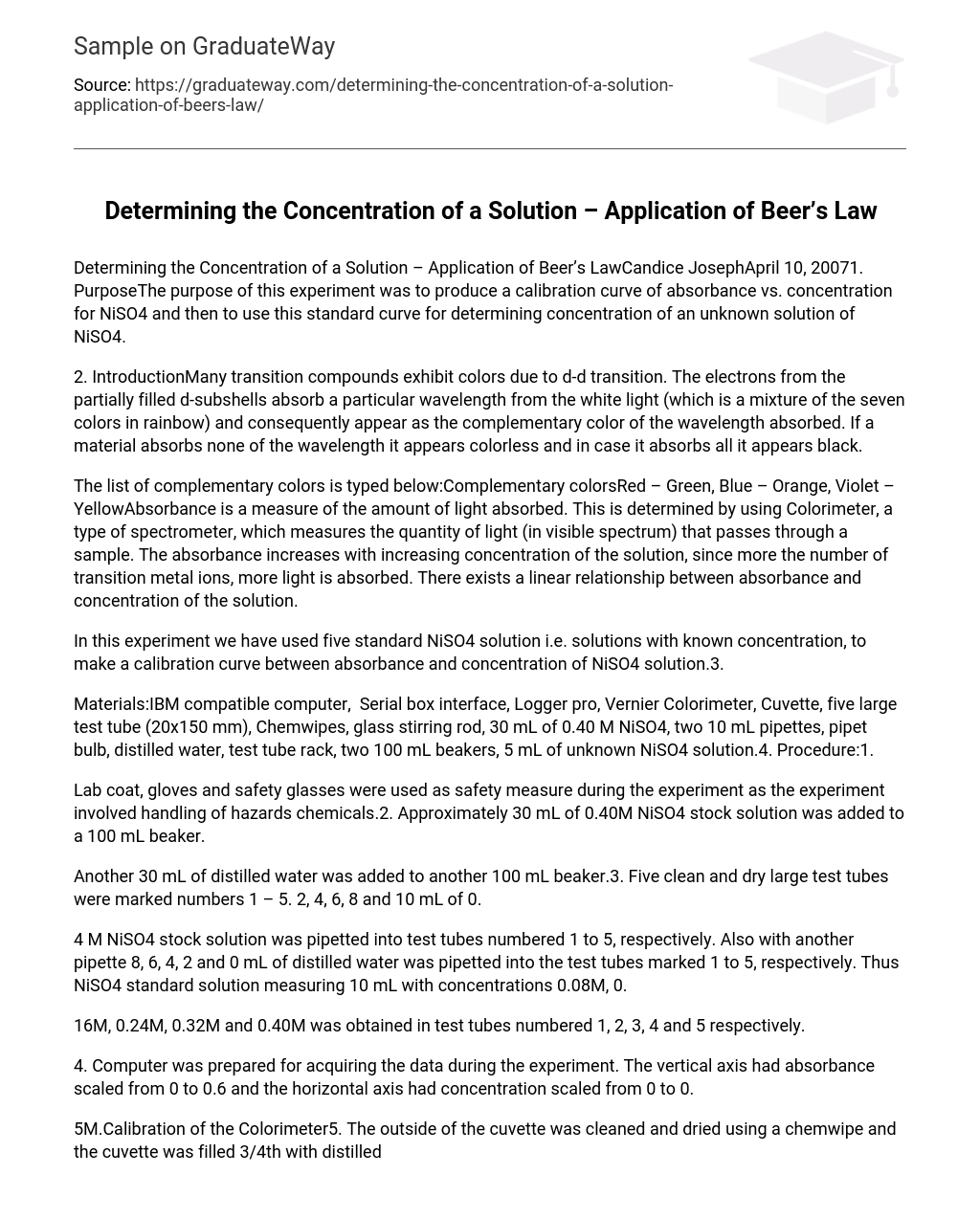Purpose
The purpose of this experiment was to produce a calibration curve of absorbance vs. concentration for NiSO4 and then to use this standard curve for determining concentration of an unknown solution of NiSO4.
Introduction
Many transition compounds exhibit colors due to d-d transition. The electrons from the partially filled d-subshells absorb a particular wavelength from the white light (which is a mixture of the seven colors in rainbow) and consequently appear as the complementary color of the wavelength absorbed. If a material absorbs none of the wavelength it appears colorless and in case it absorbs all it appears black.
The list of complementary colors is typed below:Complementary colorsRed – Green, Blue – Orange, Violet – YellowAbsorbance is a measure of the amount of light absorbed. This is determined by using Colorimeter, a type of spectrometer, which measures the quantity of light (in visible spectrum) that passes through a sample. The absorbance increases with increasing concentration of the solution, since more the number of transition metal ions, more light is absorbed. There exists a linear relationship between absorbance and concentration of the solution.
In this experiment we have used five standard NiSO4 solution i.e. solutions with known concentration, to make a calibration curve between absorbance and concentration of NiSO4 solution.
Materials
IBM compatible computer, Serial box interface, Logger pro, Vernier Colorimeter, Cuvette, five large test tube (20×150 mm), Chemwipes, glass stirring rod, 30 mL of 0.40 M NiSO4, two 10 mL pipettes, pipet bulb, distilled water, test tube rack, two 100 mL beakers, 5 mL of unknown NiSO4 solution.
Procedure
- Lab coat, gloves and safety glasses were used as safety measure during the experiment as the experiment involved handling of hazards chemicals.
- Approximately 30 mL of 0.40M NiSO4 stock solution was added to a 100 mL beaker. Another 30 mL of distilled water was added to another 100 mL beaker.
- Five clean and dry large test tubes were marked numbers 1 – 5. 2, 4, 6, 8 and 10 mL of 0. M NiSO4 stock solution was pipetted into test tubes numbered 1 to 5, respectively. Also with another pipette 8, 6, 4, 2 and 0 mL of distilled water was pipetted into the test tubes marked 1 to 5, respectively. Thus NiSO4 standard solution measuring 10 mL with concentrations 0.08M, 0. 16M, 0.24M, 0.32M and 0.40M was obtained in test tubes numbered 1, 2, 3, 4 and 5 respectively.
- Computer was prepared for acquiring the data during the experiment. The vertical axis had absorbance scaled from 0 to 0.6 and the horizontal axis had concentration scaled from 0 to 0. 5M.Calibration of the Colorimeter
- The outside of the cuvette was cleaned and dried using a chemwipe and the cuvette was filled 3/4th with distilled water in a manner to avoid bubbles in the solution. The cuvette was placed in the colorimer’s cuvette slot with the reference mark facing the white reference mark at the right of the colorimeter and the opaque side perpendicular to the direction of the light source.
- From the experimental menu calibration was performed. The blank cuvette was inserted into the colorimeter and the lid was closed. The wavelength nob of the colorimeter was turned to the 0%T position, 0 was typed in the %edit box and keep was clicked.
- For 2nd reading the wavelength knob of the colorimeter was turned to Red position, 100 was typed in % edit box and keep was clicked.Preparing the Calibration Curve.
- The cuvette was emptied and rinsed with the 0.08M NiSO4 standard solution. This solution was then filled into the cuvette upto 3/4th full. The solution was discarded and again filled with the same solution. The cuvette was filled thrice, discarding the solution filled twice. The cuvette was placed inside the colorimeter. When the reading stabilized keep was clicked. 0.08 was typed in the % edit box and the entry was stored.
- Step 8 was repeated for the remaining standard NiSO4 solutions 0.16M, 0.24M, 0. 32M and 0.40M.
- The graph was plotted and printed.
- In the similar manner absorbance of the unknown NiSO4 solution.12. A line plot between absorbance and concentration of the NiSO4 solution was plotted in Excel and a linear trend line passing through origin was also plotted and the equation of the linear trendline was obtained.
Results and Analysis
The plot between absorbance and concentration for standard solutions and the linear trend line is presented in figure 1, below:The linear trendline equation between absorbance and concentration is y = 1.3266x; R2 = 0.9814Because nickel sulfate solution is green, therefore, it absorbs the Red light as red is the complementary color of green.
Because the solution absorbs red colors therefore, red light was used in this experiment. If the solution was orange, then blue line would have been used.Using the linear trendline equation y = 1.3266x, concentration of the unknown solution isx = 0. 268/1.326 M = 0.21M3. Then was done because, when there is no NiSO4 solution all the light passes through thecuvette.
Not exactly as my R2 value for my data is 0.9814 slightly less than 0.99, but this value is also indicative of very good linear fit. The required absorbance value will be y = 1. 326x = 1.326*0.50 = 0.6636. The concentration of this new standard solution will be (0.40M * 3)/(3+7) = 0.12M7.
This is to ensure that no air gap or air bubble is present in the solution and also the solution in the cuvette is not contaminated by the previous solution or diluted by the distilled water. Understanding of the Chemistry of BreathalyzersCandice JosephApril 10, 20071.





